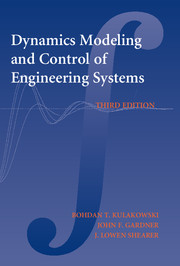Book contents
- Frontmatter
- Contents
- Preface
- Dynamic Modeling and Control of Engineering Systems
- 1 INTRODUCTION
- 2 MECHANICAL SYSTEMS
- 3 MATHEMATICAL MODELS
- 4 ANALYTICAL SOLUTIONS OF SYSTEM INPUT–OUTPUT EQUATIONS
- 5 NUMERICAL SOLUTIONS OF ORDINARY DIFFERENTIAL EQUATIONS
- 6 SIMULATION OF DYNAMIC SYSTEMS
- 7 ELECTRICAL SYSTEMS
- 8 THERMAL SYSTEMS
- 9 FLUID SYSTEMS
- 10 MIXED SYSTEMS
- 11 SYSTEM TRANSFER FUNCTIONS
- 12 FREQUENCY ANALYSIS
- 13 CLOSED-LOOP SYSTEMS AND SYSTEM STABILITY
- 14 CONTROL SYSTEMS
- 15 ANALYSIS OF DISCRETE-TIME SYSTEMS
- 16 DIGITAL CONTROL SYSTEMS
- APPENDIX 1 Fourier Series and the Fourier Transform
- APPENDIX 2 Laplace Transforms
- APPENDIX 3 MATLAB Tutorial
- APPENDIX 4 Simulink Tutorial
- Index
8 - THERMAL SYSTEMS
Published online by Cambridge University Press: 05 June 2012
- Frontmatter
- Contents
- Preface
- Dynamic Modeling and Control of Engineering Systems
- 1 INTRODUCTION
- 2 MECHANICAL SYSTEMS
- 3 MATHEMATICAL MODELS
- 4 ANALYTICAL SOLUTIONS OF SYSTEM INPUT–OUTPUT EQUATIONS
- 5 NUMERICAL SOLUTIONS OF ORDINARY DIFFERENTIAL EQUATIONS
- 6 SIMULATION OF DYNAMIC SYSTEMS
- 7 ELECTRICAL SYSTEMS
- 8 THERMAL SYSTEMS
- 9 FLUID SYSTEMS
- 10 MIXED SYSTEMS
- 11 SYSTEM TRANSFER FUNCTIONS
- 12 FREQUENCY ANALYSIS
- 13 CLOSED-LOOP SYSTEMS AND SYSTEM STABILITY
- 14 CONTROL SYSTEMS
- 15 ANALYSIS OF DISCRETE-TIME SYSTEMS
- 16 DIGITAL CONTROL SYSTEMS
- APPENDIX 1 Fourier Series and the Fourier Transform
- APPENDIX 2 Laplace Transforms
- APPENDIX 3 MATLAB Tutorial
- APPENDIX 4 Simulink Tutorial
- Index
Summary
LEARNING OBJECTIVES FOR THIS CHAPTER
8–1 To recognize the A- and D-type elements of thermal systems.
8–2 To identify and model the three fundamental modes of heat transfer.
8–3 To use the energy-balance method to develop models of lumped-parameter thermal systems.
INTRODUCTION
Fundamentals of mathematical methods used today to model thermal systems were developed centuries ago by such great mathematicians and scientists as Laplace, Fourier, Poisson, and Stefan. The analytical solution of the equations describing the basic mechanisms of heat transfer – conduction, convection, and radiation– was always considered to be an extremely challenging mathematical problem. The study of energy transfer in thermal systems continues to be an important topic in engineering because it forms the basis of analysis of energy efficiency for indoor environmental controls, industrial processes, and all forms of energy transformation.
As described in Chap. 1, temperature is an A-type variable, determining the amount of energy stored in a thermal capacitance, the A-type energy-storing element corresponding to a mass in mechanical systems or a capacitor in electrical systems. All matter has thermal capacitance (which is proportional to mass), and energy is stored as internal energy because of its temperature. The T-type variable in thermal systems is heat flow rate Qh; however, as was pointed out in Section 1.2, there is no T-type element in thermal systems that would be capable of storing energy as a result of heat flow rate. The D-type element in thermal systems is the thermal resistor and will be defined as the resistance to heat transfer.
- Type
- Chapter
- Information
- Dynamic Modeling and Control of Engineering Systems , pp. 198 - 218Publisher: Cambridge University PressPrint publication year: 2007
- 1
- Cited by

